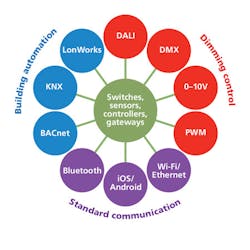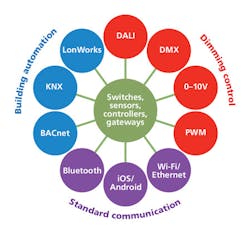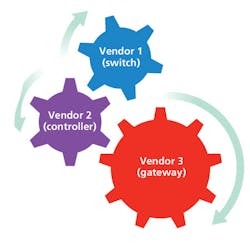Lighting controls based on open standards, says PATRICK DURAND, can address lighting OEMs' concerns regarding complexity and scalability of systems as well as interoperability of fixtures and control components, and achieve flexibility for indoor commercial lighting applications.
When lighting OEMs are bidding on projects, they are increasingly being asked to include a compatible lighting control system (typically from a third-party lighting control vendor) in the proposal, where the requirements of the control system are specified to the lighting OEM. Until now, many lighting OEMs have been responding in a reactive way to these requests without developing a formal, proactive strategy regarding lighting controls.
Should we wait for a global lighting-control standard?
The principal reason for the hesitance to proactively implement a lighting control strategy is the confusion around which technology or vendor to invest in, particularly when it comes to lighting control systems for the indoor commercial and office environments. Very few lighting OEMs have the time, resources, or expertise to evaluate the merits of all lighting control technologies.
For residential lighting control (i.e., smart bulbs), the dominant protocol is clear, where ZigBee Light Link has been declared the winner with multiple lighting OEMs supporting the protocol. However, for indoor commercial and office lighting controls, the technology options remain varied (Fig. 1) and growing. Many lighting OEMs are choosing to wait until there is a dominant or de facto standard in order to avoid an improper technology selection at this early stage in the lighting control lifecycle.
FIG. 1. Lighting control technology options are abundant, which can be confusing for lighting OEMs being asked to develop a compatible controls system.
There are three major reasons for the lack of a dominant global standard. The first is that dominant lighting control technologies and/or dominant LED driver dimming signals vary by region. For instance, 0-10V is the dominant LED driver dimming signal in North America, while DALI (digital addressable lighting interface) and pulsewidth modulation (PWM) are dominant in Europe and Japan, respectively. From a building automation system standpoint, although BACnet appears to be a dominant global protocol, KNX is very popular in Europe. Therefore, in order for lighting OEMs to cater to end customers in various regions, it becomes difficult to rely on a single technology.
The second reason is that lighting control installations vary by complexity. At one end of the spectrum, some installations simply require an occupancy sensor to provide a signal to an LED driver to turn on/off depending on whether someone is in the room. These simple systems act independently if there are multiple instances in different rooms throughout a building with no gateway to link them to a centralized control system. At the other end of the spectrum, there are centralized lighting control systems that manage, monitor, and control lighting throughout the entire building or even multiple buildings within a city, country, or around the world. The type of technology that is generally leveraged to create these simple versus complex systems tends to differ dramatically. As a result, this poses another challenge for a lighting OEM to rely on a single lighting control technology.
The third and most impactful reason why there will likely never be a single dominant lighting-control technology for indoor commercial and office lighting is due to the fact that the lighting OEM does not mandate the lighting control technology for any given project. This is the responsibility of the specifier, architect, building owner, or building manager.
With these challenges in mind, what is a lighting OEM to do when selecting a lighting control technology to develop a proactive lighting control strategy? The answer for many lighting OEMs has been to simply wait due to the confusion and perceived complexity. The reality is that many options exist, and depending on the application, certain criteria can be evaluated to determine the optimal solution to be implemented to win the business. The answer is to select a lighting control technology based on the following five criteria: flexibility, interoperability, simplicity, scalability, and proven technology.
Flexibility and interoperability
All lighting control technologies fall into one of two major technology categories: proprietary technology or open technology. Products from a particular vendor leveraging proprietary technology only function with other products from that same vendor. Lighting control companies that have developed proprietary technologies have followed this business model due to the merits of their technology-driven value proposition or due to their strong channel to market (particularly for well-established companies). Proprietary technologies can be suitable for specific lighting control projects where there is a good technological fit or if the proprietary technology has been directly specified as an approved lighting control solution.
By comparison, open technologies are based on open or public standards that allow multiple companies to develop products leveraging the same fundamental protocol; this enables products from different vendors to be interoperable and work as a system (Fig. 2). As a result, open technologies provide lighting OEMs with the flexibility to choose between a number of vendors in order to mix and match various solutions based on features, form factor, and pricing to meet an end customer's lighting control requirements.
FIG. 2. Open standards for lighting control can bring together varying products and building systems designed by multiple vendors that leverage the same protocol.
For lighting controls in indoor commercial and office environments, there are two major open technologies: EnOcean and ZigBee. EnOcean is the first and only ISO/IEC wireless standard (14543-3-10) optimized for solutions with ultralow power consumption and energy harvesting. As a result, lighting OEMs that leverage EnOcean technology can benefit from the added advantage of offering wireless switches and sensors that require no power and no batteries, since the kinetic energy from pressing on the switch or the solar cells from the sensor are sufficient to power the EnOcean radio. The EnOcean Alliance currently comprises more than 350 members from all regions of the world with over 1,300 interoperable products.
ZigBee is based on the IEEE 802.15.4 standard where 802.15.4 defines the physical and MAC layers, while ZigBee defines the network and application layers. All ZigBee or 802.15.4-based lighting control vendors, except for one, have decided to customize their implementation of ZigBee or develop a proprietary protocol based on 802.15.4. This is due to inherent complications of ZigBee for use in indoor commercial and office lighting environments. In practice, this makes ZigBee more of a proprietary protocol since most lighting control products leveraging ZigBee or 802.15.4 are not interoperable between vendors. The lone exception is a vendor that has incorporated the extra intelligence that ZigBee requires into their gateway. As a result, end nodes (switches, controllers, sensors) from different vendors that have implemented non-customized ZigBee can be interoperable with the gateway from this vendor, but this subsequently limits the lighting OEM's choice of gateway providers.
Fig. 3 illustrates the various options that a specifier, architect, building owner, or building manager will specify from a dimming control, standard communication, and building automation system (BAS) standpoint. For example, a given project may require that the lighting control system support a BACnet BAS with occupancy and daylight harvesting sensors where the luminaires must be controlled by DALI signals. Alternatively, the specification could state that the lighting control system must be controlled and monitored via smartphone and tablet where the luminaires are controlled by 0-10V signals. If the selected technology or vendor that the lighting OEM has aligned themselves with is not flexible enough, then the lighting OEM will eventually be forced to leverage multiple technologies from multiple vendors. This puts a strain on resources, particularly the lighting OEM's sales and sales representative teams that must position the luminaire and control solutions to the end customer.
FIG. 3. Lighting control flexibility can be achieved by using existing interoperable components in the open-technology-based system.
Simplicity and scalability
Some end customers, like building owners and building managers, are not ready to incorporate a BAS or a centralized lighting control system that they can control, schedule, and monitor via a computer or mobile device. Instead, these end customers prefer to limit the lighting control solution to switches, sensors, and controllers (typically 0-10V relays and DALI controllers) for LED drivers without the need for a gateway or complicated network device. In other words, these end customers want a simple standalone lighting control system for each room within a building.
For now, there are two major available options for simple, standalone lighting control systems: The first is from a well-established proprietary lighting control vendor and the other is EnOcean technology. Conversely, the currently available ZigBee or 802.15.4-based lighting control systems require the use of a gateway or network device. With standalone systems, commissioning can be as simple as pressing a button on the wireless switch and a button on the wireless controller to pair the devices. There are also commissioning options with wireless USB dongles for some lighting control systems with PC software to fine-tune some of the wireless device (i.e., sensor and controller) settings.
FIG. 4. In this example, EnOcean supports simple and scalable lighting control systems with a single technology.
Consider a case where months or years after the installation of the simple standalone lighting control system, the building owner or manager decides to leverage a BAS or wants to centralize lighting control, scheduling, and monitoring from a PC/smartphone/tablet. EnOcean technology can seamlessly and easily convert from a simple standalone system to a scalable networked system without having to change the existing lighting control system (Fig. 4). ZigBee and 802.15.4-based lighting control systems are designed to be scalable to a full building and even multiple buildings, but the starting point will always require a gateway or network device.
Proven control technology and support
Building owners and building managers typically do not want their building to be a test site for emerging technologies. As a result, the lighting control technology that lighting OEMs will promote for projects must be a proven technology.
The leading ZigBee and 802.15.4 lighting control vendors each have an installed base of hundreds to multiple thousands of buildings. The EnOcean Alliance indicated that EnOcean technology has been installed in over 350,000 buildings throughout the world.
While ZigBee and 802.15.4 technologies are very reliable and have been proven in real-world settings, EnOcean technology may increase the chances for lighting OEMs to consistently win projects in different regions of the world due to the technology's significant international installation base. As a result, this will avoid the need for a lighting OEM to understand and promote different technologies based on the project's location as an increasing number of lighting OEMs are selling their luminaires in multiple markets.
Future Lighting Solutions (FLS) has been supporting its lighting OEM customers with LEDs, drivers, optics, connectors/sockets, and thermal solutions for over a decade. FLS has the knowledge and supplier partners that support the EnOcean standard and alliance, as well as other platforms, to assist OEMs in the development and implementation of wireless solutions.
PATRICK DURAND is the worldwide technical director at Future Lighting Solutions (futurelightingsolutions.com).









